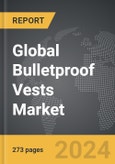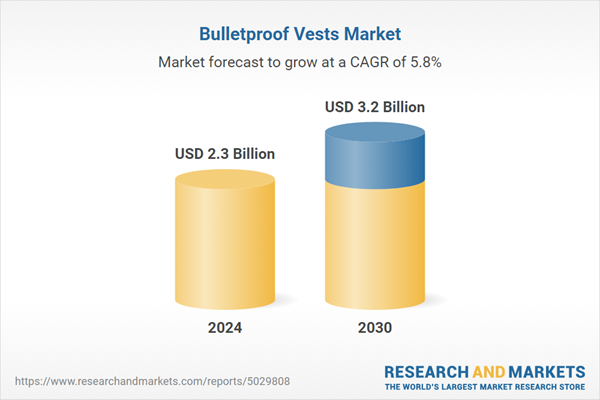The global market for Bulletproof Vests was valued at US$2.3 Billion in 2024 and is projected to reach US$3.2 Billion by 2030, growing at a CAGR of 5.8% from 2024 to 2030. This comprehensive report provides an in-depth analysis of market trends, drivers, and forecasts, helping you make informed business decisions. The report includes the most recent global tariff developments and how they impact the Bulletproof Vests market.
Segments: Type (Soft, Hard); End-Use (Defense, Law Enforcement Agencies, Civilians).
Geographic Regions/Countries: World; United States; Canada; Japan; China; Europe (France; Germany; Italy; United Kingdom; Spain; Russia; and Rest of Europe); Asia-Pacific (Australia; India; South Korea; and Rest of Asia-Pacific); Latin America (Argentina; Brazil; Mexico; and Rest of Latin America); Middle East (Iran; Israel; Saudi Arabia; United Arab Emirates; and Rest of Middle East); and Africa.
The analysts continuously track trade developments worldwide, drawing insights from leading global economists and over 200 industry and policy institutions, including think tanks, trade organizations, and national economic advisory bodies. This intelligence is integrated into forecasting models to provide timely, data-driven analysis of emerging risks and opportunities.
Global Bulletproof Vests Market - Key Trends and Drivers Summarized
Why Are Bulletproof Vests So Essential in Modern Security?
Bulletproof vests have emerged as a cornerstone of personal safety, particularly for those engaged in law enforcement, military operations, and private security. But why are these vests so essential in today's complex security landscape? These vests, often referred to as ballistic vests, serve the critical purpose of absorbing and dispersing the kinetic energy of bullets fired from firearms, potentially saving the lives of those in high-risk situations. Their history dates back to early rudimentary designs in the early 20th century, but it was only after significant advancements in materials science during the 1960s and 1970s that they became widely adopted. Modern bulletproof vests are typically crafted from advanced synthetic materials like Kevlar and ultra-high-molecular-weight polyethylene, which are both renowned for their ability to dissipate the energy from projectiles. Earlier models were often heavy and cumbersome, but with continual innovations, contemporary vests are far more lightweight, flexible, and capable of providing critical protection while allowing for the mobility needed to perform essential tasks under pressure.What Types of Threats Are Bulletproof Vests Designed to Address?
One might ask, what specific threats are bulletproof vests designed to protect against? The reality is that these vests are tailored to address various levels of ballistic threats, depending on their design and the materials used in their construction. Bulletproof vests are classified by the level of protection they offer, according to standards established by authorities such as the National Institute of Justice (NIJ). Vests rated at lower levels, such as Level II and Level IIIA, are intended to stop bullets from common handguns, such as 9mm rounds or .44 magnum bullets. On the other hand, higher-rated vests, such as Levels III and IV, are designed to resist more potent threats, including rifle bullets and even armor-piercing rounds when equipped with hard armor plates. These advanced vests are used in scenarios involving heightened risks, such as military combat or high-stakes security operations. However, it's important to note that no vest is entirely invulnerable under all conditions. Various factors, such as the type of ammunition, the angle of impact, and the distance from which the shot is fired, can all influence a vest's effectiveness. This variability underscores the importance of selecting the right level of protection based on the specific threat environment, ensuring that the wearer is adequately shielded from potential dangers.How Has Technological Innovation Shaped the Bulletproof Vest Industry?
The evolution of bulletproof vests has been heavily influenced by advancements in materials science and engineering. Breakthroughs in the development of new high-performance fabrics, such as aramid fibers and ultra-strong polymers, have revolutionized the field. These materials possess exceptional tensile strength, enabling them to catch and deform bullets on impact, dispersing the force over a broader area and preventing penetration. In recent years, emerging technologies like graphene and nanomaterials have further enhanced the protective qualities of body armor while simultaneously reducing its weight. These innovations are critical for improving the functionality of vests, making them lighter and more comfortable without compromising on safety. Additionally, the design of bulletproof vests has evolved to prioritize ergonomics, with modern vests offering a more tailored fit that enhances wearer comfort and mobility. This evolution has been particularly important for security personnel and soldiers, who need freedom of movement during high-intensity operations. In some instances, manufacturers have even integrated cooling systems and moisture-wicking fabrics into vests to improve comfort in extreme climates. Innovations in smart technology are poised to play a role in the industry, with future vests potentially incorporating sensors that can monitor a wearer’s vital signs, detect impacts, and even send alerts in case of injury, further enhancing personal safety.What Factors Are Driving the Growth of the Bulletproof Vest Market?
The growth in the bulletproof vest market is driven by several factors, reflecting technological advancements, changing consumer needs, and evolving geopolitical conditions. One of the primary drivers is the heightened emphasis on personal safety within law enforcement, military, and private security sectors, which has led to increased investments in personal protective equipment. Escalating global conflicts, terrorism, and civil unrest have contributed significantly to the demand for advanced protective gear, as personnel face more dangerous environments than ever before. Moreover, trends such as organized crime, gun violence, and the increasing use of firearms in urban areas have prompted police forces and security agencies to adopt more sophisticated body armor. Technological innovations in ballistic materials have also fueled market expansion, as manufacturers develop lighter, more flexible vests that offer enhanced protection without sacrificing comfort or mobility. This shift towards high-performance vests has broadened the market, as not only professionals but also civilians in high-crime areas seek personal protection solutions. Furthermore, the privatization of security services has contributed to a rising demand for bulletproof vests, as more private security firms equip their employees with state-of-the-art protective gear. Government regulations mandating upgraded protective equipment for public safety officers have also contributed to the increased market demand. Research into smart textiles promises to be a major driver of innovation, ensuring the bulletproof vest market continues to grow in both scope and sophistication.Report Scope
The report analyzes the Bulletproof Vests market, presented in terms of units. The analysis covers the key segments and geographic regions outlined below.Segments: Type (Soft, Hard); End-Use (Defense, Law Enforcement Agencies, Civilians).
Geographic Regions/Countries: World; United States; Canada; Japan; China; Europe (France; Germany; Italy; United Kingdom; Spain; Russia; and Rest of Europe); Asia-Pacific (Australia; India; South Korea; and Rest of Asia-Pacific); Latin America (Argentina; Brazil; Mexico; and Rest of Latin America); Middle East (Iran; Israel; Saudi Arabia; United Arab Emirates; and Rest of Middle East); and Africa.
Key Insights:
- Market Growth: Understand the significant growth trajectory of the Soft Bulletproof Vests segment, which is expected to reach US$2.4 Billion by 2030 with a CAGR of a 6.0%. The Hard Bulletproof Vests segment is also set to grow at 5.1% CAGR over the analysis period.
- Regional Analysis: Gain insights into the U.S. market, valued at $593.9 Million in 2024, and China, forecasted to grow at an impressive 8.6% CAGR to reach $728.1 Million by 2030. Discover growth trends in other key regions, including Japan, Canada, Germany, and the Asia-Pacific.
Why You Should Buy This Report:
- Detailed Market Analysis: Access a thorough analysis of the Global Bulletproof Vests Market, covering all major geographic regions and market segments.
- Competitive Insights: Get an overview of the competitive landscape, including the market presence of major players across different geographies.
- Future Trends and Drivers: Understand the key trends and drivers shaping the future of the Global Bulletproof Vests Market.
- Actionable Insights: Benefit from actionable insights that can help you identify new revenue opportunities and make strategic business decisions.
Key Questions Answered:
- How is the Global Bulletproof Vests Market expected to evolve by 2030?
- What are the main drivers and restraints affecting the market?
- Which market segments will grow the most over the forecast period?
- How will market shares for different regions and segments change by 2030?
- Who are the leading players in the market, and what are their prospects?
Report Features:
- Comprehensive Market Data: Independent analysis of annual sales and market forecasts in US$ Million from 2024 to 2030.
- In-Depth Regional Analysis: Detailed insights into key markets, including the U.S., China, Japan, Canada, Europe, Asia-Pacific, Latin America, Middle East, and Africa.
- Company Profiles: Coverage of players such as AR500 Armor, Black Hawk, BulletBlocker, Canadian Armour Ltd.,, Imperial Armour and more.
- Complimentary Updates: Receive free report updates for one year to keep you informed of the latest market developments.
Some of the 41 companies featured in this Bulletproof Vests market report include:
- AR500 Armor
- Black Hawk
- BulletBlocker
- Canadian Armour Ltd.,
- Imperial Armour
- Point Blank Enterprises, Inc.
- PPSS Group
- Survival Armor
- U.S. Armor Corporation
- Under Armour, Inc.
- VestGuard UK Ltd.
Tariff Impact Analysis: Key Insights for 2025
Global tariff negotiations across 180+ countries are reshaping supply chains, costs, and competitiveness. This report reflects the latest developments as of April 2025 and incorporates forward-looking insights into the market outlook.The analysts continuously track trade developments worldwide, drawing insights from leading global economists and over 200 industry and policy institutions, including think tanks, trade organizations, and national economic advisory bodies. This intelligence is integrated into forecasting models to provide timely, data-driven analysis of emerging risks and opportunities.
What’s Included in This Edition:
- Tariff-adjusted market forecasts by region and segment
- Analysis of cost and supply chain implications by sourcing and trade exposure
- Strategic insights into geographic shifts
Buyers receive a free July 2025 update with:
- Finalized tariff impacts and new trade agreement effects
- Updated projections reflecting global sourcing and cost shifts
- Expanded country-specific coverage across the industry
Table of Contents
I. METHODOLOGYII. EXECUTIVE SUMMARY2. FOCUS ON SELECT PLAYERSIII. MARKET ANALYSISSOUTH KOREAREST OF ASIA-PACIFICARGENTINABRAZILMEXICOREST OF LATIN AMERICAIRANISRAELSAUDI ARABIAUNITED ARAB EMIRATESREST OF MIDDLE EASTIV. COMPETITION
1. MARKET OVERVIEW
3. MARKET TRENDS & DRIVERS
4. GLOBAL MARKET PERSPECTIVE
UNITED STATES
CANADA
JAPAN
CHINA
EUROPE
FRANCE
GERMANY
ITALY
UNITED KINGDOM
SPAIN
RUSSIA
REST OF EUROPE
ASIA-PACIFIC
AUSTRALIA
INDIA
LATIN AMERICA
MIDDLE EAST
AFRICA
Companies Mentioned (Partial List)
A selection of companies mentioned in this report includes, but is not limited to:
- AR500 Armor
- Black Hawk
- BulletBlocker
- Canadian Armour Ltd.,
- Imperial Armour
- Point Blank Enterprises, Inc.
- PPSS Group
- Survival Armor
- U.S. Armor Corporation
- Under Armour, Inc.
- VestGuard UK Ltd.
Table Information
| Report Attribute | Details |
|---|---|
| No. of Pages | 273 |
| Published | April 2025 |
| Forecast Period | 2024 - 2030 |
| Estimated Market Value ( USD | $ 2.3 Billion |
| Forecasted Market Value ( USD | $ 3.2 Billion |
| Compound Annual Growth Rate | 5.8% |
| Regions Covered | Global |









